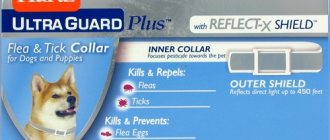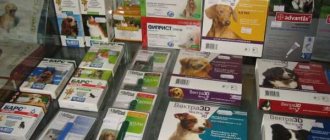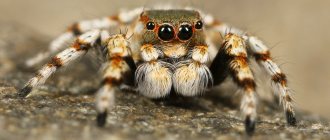Possible reasons
Most often, itchy dermatitis is caused by ectoparasites. But what to do when your dog itches a lot but doesn’t have fleas? The owner takes care of the pet, regularly treats the skin with insecticidal sprays or drops, but pruritus bothers the dog. Insect attacks most often occur in the summer, but the animal itches even in cold weather, when there are no fleas. The following factors cause itching are distinguished:
- Stress.
- Injuries.
- Contact with irritants.
- Exposure to heat or cold.
- Parasites.
- Allergy.
- Infection.
In all cases, when eliminating itchy dermatitis, in addition to specific medications, antibacterial agents, as well as antimycotics, will be required.
Allergies in dogs: symptoms
In order to diagnose a food allergy, a special diagnosis is carried out, which is called an elimination diet. At first, foods that are part of the dog’s usual diet are removed from the dog’s diet, and then they are gradually returned. After this, the dog’s owner looks at which product was administered when the relapse occurred. Most often, this diet is introduced with full confidence that the dog does not have fleas, scabies mites, and other pathogens that provoke severe itching and hair loss in certain places.
Allergies in dogs, symptoms:
- Allergies in four-legged friends manifest themselves in the same way as in people. Usually this is redness of the eyes, discharge of a large amount of mucus from the nose and mouth, rashes, redness, and severe itching.
- In general, the dog may feel quite unwell and may feel unwell. However, the temperature remains normal.
- Typically, allergy rashes appear on the face, ears, and in the folds of the skin, under the paws. Often redness and pimples appear in these areas, which the dog may scratch.
Cute dogs
Stress
Dogs, especially puppies, are impressionable creatures. After purchase, the baby is brought to a new home. Everything is unusual: the food, the decor, the people around you. The pet experiences a feeling of itchy skin. The puppy is itching, but there are no fleas.
Similar symptoms are observed in adults during or after an expert exhibition. Some dogs do not cope well with travel and transportation. An inadequate reaction to changes in living conditions also occurs in adult dogs. Transferring from a kennel to an apartment or vice versa causes a feeling of confusion. There are individual and breed predispositions to stress.
The irritated condition in most cases goes away without treatment, the itching stops spontaneously. However, the dog owner needs to watch the pet. If you notice that your dog reacts violently to changes in the environment, Stop Stress or Kot Bayun medications can help. They should be taken 5 days before the expected event and for the same time after.
Check out our review of sedatives for dogs.
Injuries and wounds
The skin around the affected area becomes hyperemic, swollen, and itchy. Ulcers form. The dog scratches the sore spot, the pathological surface expands. If your dog has had surgery, the healing stitch may also be itchy. Help consists in the destruction of microflora, the waste products of which cause pruritis.
I recommend Terramycin.
Use an antiseptic aerosol. If the itchy areas are covered with hair, cut it off and treat the wound surface with a spray as needed. Terramycin spray, Alamicin, and other antiseptics are in demand.
Contact with irritants
Indoor dogs are regularly treated with insecticides, because ectoparasites plague not only pets. The animal does not have fleas, but it is constantly itching. It is necessary to analyze what physical or chemical irritants can cause itching.
In winter, the decorative dog lives close to heating radiators. The skin dries out and cracks. Skin defects are inseminated by the microflora that constantly lives on the dog, and dermatitis develops. They use aerosol antiseptics and move the dog’s den away from the battery.
Excessive care for your pet leads to the opposite result. Bathing with a low-quality detergent dries out the skin and causes pruritis. If you frequently bathe your pet with a good shampoo, he will also develop itchy dermatitis. The protective fat layer is washed off from the surface of the skin, as well as hairs. The hairs break, the skin dries out. Dogs do not need to be bathed unless they are very dirty.
Most situations do not require drug treatment. Recovery occurs after the causes are eliminated.
Allergic reaction to various irritants
If your dog is constantly itching and testing for fleas and other parasites is negative, you may suspect an allergy caused by the following factors:
- flea bites;
- substances entering the body by air;
- chemicals from hygiene products;
- food or its change;
- vaccines and vaccinations.
The human and dog bodies are very different and, despite the fact that the allergic components are similar and their mechanism of action is the same, the symptoms are different. In dogs, allergies are prolonged by itching and skin disorders. Subsequently, a secondary infection takes root at the site of severe scratching, which is accompanied by inflammation.
Fleas cause allergies, which is the body's reaction to a foreign protein that enters the bloodstream with the secretions of the insect's salivary glands. Even one flea caught on a dog can cause an allergy in the animal that once suffered from fleas.
Atopic dermatitis, which doctors estimate affects 4 to 16% of dogs, is caused by:
- plant pollen;
- household dust;
- excrement and particles of chitinous cover of synanthropic insects;
- mold fungi;
- dead particles of the epidermis;
- bird feathers and down.
Atopic dermatitis in dogs
Interesting!
When an allergen enters the body, it stimulates the formation of antibodies, the synthesis of which depends on genetic predisposition. Skin-sensitizing antibodies are formed in the cells, combining into antigen/reagent complexes. It is they and the bioactive substances released during the tissue reaction that lead to rashes, the feeling of “goosebumps” due to involuntary twitching of small muscles, and itching.
The dog often itches, especially in the area of the toes, belly, tail, and back. Red spots form under the fur, which are easy to notice, especially in short-haired dog breeds.
Food allergies are caused by proteins (anaphylaxis) or non-protein components of food (atopy). It is necessary to distinguish between intolerance to certain foods and true allergies, therefore, only a specialist can decide how to treat a food allergy after a differential diagnosis.
Allergens
Allergies in dogs are most often caused by foods such as horse meat, beef, and milk. The second group of allergenic products are soy, chicken, and lamb. Many premium foods contain these products. The allergy is accompanied by such severe itching that the dog itching, biting these places, can completely erase the incisors. At the site of severe licking, hair falls out, leading to complete baldness, discoloration of the coat, pyoderma, coarsening and hyperpigmentation of the epidermis.
In long-haired dogs, an allergic reaction provokes the development of a severe form of dermatitis. If the Pekingese itches, and on parts of the body the fur is noticeable, sticking together, as if from saliva, then the cause may be wet dermatitis. When cutting the wool, a very complex picture of pathology becomes visible.
Allergies can be triggered by the use of medications - eye and ear drops, vaccines, etc. The manifestations are the same as with other types of allergies. If your dog itches after taking flea drops, then it is highly likely that he is allergic to this product.
Dermatosis, which is accompanied by itching, can be caused by contact with the collar. This form of the disease is often observed in puppies, since their delicate skin is very sensitive to constant exposure to insecticides. The puppy is itching, trying to remove the collar.
To treat allergic reactions, veterinarians prescribe cortisone and other antihistamines that help relieve skin manifestations and itching (Benadryl, Tavist, Amitriptyline, Atarax).
Exposure to heat or cold
The dog licks the burned or frostbitten surface. Acral dermatitis develops. Decomposition products of dying tissues cause intoxication. are not enough for this treatment . Invite a veterinarian and administer antibiotic therapy under his supervision. The specialist decides which drugs to use and how to administer them - orally, intramuscularly or subcutaneously.
In the hot sun, the skin dries out and bursts. The microflora, which is ubiquitous, is activated. The slightest abrasion or mosquito bite opens the gates for infection, pustules form, and itchy pyoderma develops.
The affected surface is treated with an antiseptic spray. For prevention, cooling scarves, blankets or mats are used. Do not put wet cloth on your dog. Slowly evaporating moisture overcools the pet and causes pneumonia. If the air conditioner is on, the dog is placed in another room and the door is closed to avoid drafts, which can also cause pneumonia.
Dogs can only be bathed in clean waters. Otherwise, the microflora rapidly developing in warm water will begin to develop on the dog’s skin, causing itching.
Cooling gussets are provided for hot weather.
How to help a dog - treatment
Lice eaters, fleas and some other types of parasites disappear after using Bars or Frontline sprays. Dog breeders speak well of Barrier, Celandine, Advantix, and Blokhnet drops. For prevention purposes, you can use special collars Kiltix and Foresto.
But an animal may develop an individual intolerance to certain substances. To exclude allergies in dogs, veterinarians prescribe Cortisone, Tavist, Atarax.
Doctors advise bathing a pet that has slight itching and flaking of the skin with shampoos with an antifungal effect - Nizoral or Dermazol. For therapy, Orungal and Oronazole are prescribed. If weeping wounds have formed on the body, then antiseptic, disinfectant and drying agents are prescribed. In advanced stages, only taking antibiotics can help.
Each type of parasite provokes the manifestation of special symptoms in the animal. The dog owner should not determine the type of illness and try to figure out how to treat it. Any problem should be discussed with a veterinarian, since independent human actions can be disastrous for the animal. The doctor will tell you exactly how to help your pet and what the prospects for the future are.
Parasites
Pruritis is a symptom of a dog being infected with subcutaneous mites and nematodes . Clinical signs appear primarily in puppies and older dogs with weakened immune systems. Short-haired dogs get sick more often than long-haired dogs. Animals kept in unsatisfactory conditions and receiving unbalanced feeding are predisposed to illness. The peak of the disease is observed in the warm half of the year.
Demodexes are permanent inhabitants of dog skin. They inhabit sebaceous glands, hair follicles, and eat their contents. In animals with a strained immune system, clinical signs of the disease do not occur. Scabies is accompanied by dermatitis. The scratched surface becomes infected with microbes.
Treatment is developing in the following areas:
- Destruction of parasites . The wool is cut. Use external acaricidal preparations based on amitraz at weekly intervals. Pesticides eliminate sexually mature individuals. The eggs hatch into larvae that must be destroyed before they become sexually mature. The course of treatment consists of 3-5 treatments. An alternative is acaricidal tablets Milbemycin or Sayfli. They are safe and easy to use. But the course of treatment continues for months.
- Elimination of symptoms of dermatitis . Bacteria and fungi develop on damaged skin, which are ubiquitous. Therefore, antibiotics are used in combination with antimycotics.
- Immune stimulation . The injection agents used are Gamavit, Katozal, Phosprenil, Maxidin.
Ticks that cause sarcoptic mange, notoedrosis and otodectosis get on the skin of dogs with weakened immune systems through contact with cats or stray relatives. The principle of treatment is the same as for demodicosis. Notoedrosis is mild and often ends with spontaneous recovery. Otodectosis is characterized by damage only to the inner side of the ear. Experts consider Surolan, which is instilled into both ear canals, to be an effective drug for treating ear mites.
High infestation with nematodes is characterized by skin rashes, disheveled fur, and baldness. Parasitic worms consume all the vitamins supplied with food, block their absorption from the intestines, and release metabolic waste into the blood.
Treatment consists of deworming. Use Dirofen, Drontal or Kanikvantel. Dying parasites secrete poisons, so detoxicants are used.
Parasitic diseases and associated financial expenses for treatment can be avoided in the following ways:
- feed and maintain the dog in accordance with veterinary and sanitary requirements;
- carry out quarterly deworming;
- limit contact with stray animals.
Is flea medication safe for dogs?
Flea and tick medications are designed to both prevent external parasites from attaching and kill them if the animal becomes infected. All of them belong to ectoparasiticides, that is, agents against external parasites. For example, they will not destroy worms.
The active ingredients in medications vary depending on the type and brand of medication. The most popular of them:
- Pyrethrins. A class of organic compounds obtained from chrysanthemum plants. They are used in various types of insecticides to kill mosquitoes, fleas and ticks.
- Pyrethroids. They are obtained from the same plants as pyrethrins. Used in flea medications for dogs, but toxic to cats.
- Organophosphates. They are used in flea collars, less often in pipettes due to higher toxicity.
- Indoxacarb. It is a pesticide that is used to treat fleas on dogs and cats. Particularly useful against lepidopteran larvae, including flies and fleas.
- Fibronil. A broad-spectrum insecticide used in some of the most common pet products. Its toxicity is considered low when applied topically, but inhalation and ingestion may increase toxicity.
Allergy
Immune bodies protect the body from foreign proteins. Protective cells compare the structures of proteins received from outside with their own. If they do not match, a violent inflammatory reaction destroys the alien. When the foreigner recognition mechanism fails, an allergic response develops. Cells mistake harmless compounds for virulent ones.
A dog with a damaged immune system experiences reactions characterized by dermatitis, swelling, and conjunctivitis. If your pet itches frequently, but no fleas are found on its skin, an allergy is suspected.
An inadequate response to stimuli occurs for the following reasons:
- side effects of medications;
- response to external stimuli (atopic dermatitis);
- feed allergy.
Side effects of medications
Skin itching is the least evil that occurs as a side effect of medications. Typically, a reaction occurs to the use of medicinal serums and antibiotics. If your dog is itching, you need to find out what medications he is taking and stop them . To relieve allergy symptoms, antihistamines are used - Suprastin; Tavegil; Diphenhydramine.
Prevention of disease is the responsibility of the veterinarian prescribing treatment. The use of drugs with side effects should be avoided, and if this is not possible, oral therapeutic forms should be preferred to parenteral ones.
Atopic dermatitis
Difficult to diagnose. However, attentive dog breeders note that the acacia tree has bloomed and their beloved dog is itching. The owner used new perfume, a friend came and lit a cigarette - the dog started having problems.
Atopic dermatitis
An allergic response can occur to household chemicals, plant protection products, the smell of gasoline, indoor plants, cat hair, and street dust. Antihistamines provide only momentary relief. You can get rid of the disease if you give up your own habits and interrupt your pet’s contact with the allergen. It’s painstaking work, but the pet’s health is more important.
Feed allergy
I remember an interesting incident. A big man with a Caucasian Shepherd puppy in his arms visited the Kennel Club. The baby was 4 months old, weighed 25 kilograms. His whole face was covered in acne. The owner worked as a cook in a restaurant for sailors, fed the pet table scraps and wondered why the puppy had dermatitis. They explained to him that the cause of the illness was spices.
If you give your dog human food, be careful. Adherents of natural food need to be prepared for the fact that the pet will react to any component of the food. It is difficult to identify the irritant.
The use of ready-made feed mixtures can also have a negative impact. Therefore, change feed gradually. On the first day, mix 1/4 of the new food with 3/4 of the old. The next day, the portion of replacement food is increased. Most often, an allergic response occurs to chicken meat. Therefore, choose a recipe with duck, fish or lamb.
If such a change in diet does not help, use Hill's z/d or Royal Canin Anallergenic therapeutic food for dogs with food allergies and intolerance to food components.
What diseases cause your dog to itch?
A pet can itch for various reasons, and this problem is not always associated specifically with the skin, so before helping your pet, it is necessary to accurately establish the diagnosis. Self-treatment can not only aggravate the disease, but also lead to serious complications.
Pruritic scabies (sarcoptosis)
A pathology caused by microscopic subcutaneous mites, which are localized in the skin of the muzzle, ears, elbows, and hocks.
At the site of the lesion the following are noted:
- hair loss
- red spots
- itchy vesicles that burst and form scabs when they dry out
In later stages, the skin becomes dense and darkens. The disease is contagious not only to other pets, but also to humans.
Pityriasis scabies (wandering)
This type of disease is more common in puppies and is extremely dangerous for other dogs. The causative agent is the red mite, which parasitizes the surface of the skin.
It spreads indoors where there are sick animals, but without a host it quickly dies.
Fleas (flea dermatitis)
Scratching the body is associated with insect bites and the entry of their saliva into the wound, which provokes a reaction. In many four-legged animals, this causes minor skin itching, but severe infestation can cause anemia and death of the pet.
The parasite's favorite places are the back, the area around the tail, the back of the body, and the groin.
If the body is hypersensitive to flea saliva, allergic dermatitis (BAD) may develop.
If the dog itches, but there are no fleas, then there are other pathologies and a thorough examination of the animal is required.
Lice
Parasites are rarely found in dogs (only with poor care and the presence of mats). They are found near the ears, on the head, in the withers and anus. Nits (eggs) can only be seen under a microscope.
Insects cause intense itching, and due to constant irritation, bare areas remain on the pet's body. With extensive infestation, anemia may develop, so blood transfusions are often required, as well as a proper diet high in vitamins, iron and protein.
Ixodid tick
Small arthropods not only force the dog to scratch itself, but are also carriers of dangerous diseases.
A tick bite may cause:
- piroplasmosis (babesiosis)
- spotted fever
- Lyme disease
- tularemia
- hepatozoonoses
The tick is most often found in the neck, ears, head, interdigital space, anus, groin, and armpits. Therefore, if the dog is itching, it is necessary to conduct a thorough examination for the presence of a parasite and, if one is detected, immediately consult a veterinarian.
Pelodera (wetting hay scabies)
Street animals that sleep on a bed of damp marsh hay are susceptible to the disease. It is rare in domestic pets.
The causative agent is a thread-like worm that lives in damp grass. The larva penetrates the skin of the dog's chest, abdomen and paws, forming tubercles in the form of papules. Unbearable itching forces the mammal to scratch itself until it bleeds, which leads to infection and the development of an inflammatory reaction.
Polyzukha (pruritic dermatitis of the extremities)
Sometimes dogs lick their paws around the ankles and ankles out of boredom. The problem is more common in middle-aged, smooth-haired animals that lead a sedentary lifestyle.
From intense licking, the surface of the skin becomes red and shiny, the hair in these places falls out, and itching appears.
The habit of licking the paws leads to maceration of the skin (softening of the tissue), later it swells, becoming dense and insensitive.
Allergy
Undesirable hypersensitivity of the immune system in animals provokes an allergic reaction to many types of substances. The pathology is accompanied by itching of the skin, mucous discharge from the eyes and nose, bronchospasms, coughing and sneezing. In severe cases, vomiting and diarrhea may occur.
What could you be allergic to:
- plant pollen
- mold
- insect bites
- house dust
- some types of products
- medicines
- chemical substances
Sometimes the reaction appears immediately, in other cases it may take several days to develop.
Urticaria (nettle fever) is characterized by the rapid appearance of itchy blisters on the skin, especially around the face. Accompanied by swelling of the eyelids and deterioration of the general condition.
The reaction is caused by bites of certain types of insects, as well as vaccination, taking antibiotics, eating spoiled meat or other types of food.
Often, itchy skin can be caused by detergents and insecticides coming into contact with the body.
Atopic dermatitis (respiratory allergy) occurs at the same time of year in pollen-sensitive dogs. The animal scratches itself furiously, licks its nose, scratches its muzzle on the carpet and sneezes. Watery eyes and dark spots on the limbs are common.
In addition to the characteristic signs of hypersensitivity, there is hair loss under the arms and on the sides, redness and irritation of the skin (sometimes droplets of tissue fluid appear on it). Over time, the dermis thickens and becomes pigmented.
Food allergies (nutritional) are accompanied not only by itchy skin and the appearance of papules, blisters and pustules on the surface of the body, but also by indigestion. Occurs at any time of the year in pets prone to adverse reactions to meat, dairy products, eggs, fish, poultry, potatoes, legumes, etc.
Sometimes allergies occur not only when consuming these products, but even when in contact with an allergen. The disease develops over many years if the dog is fed the same foods, which leads to hypersensitization of the body to this type of food.
BAD (allergic flea dermatitis) - some four-legged animals have a reaction to the bites of blood-sucking insects (fleas) - the appearance of a rash. The itching of the skin continues even after the animal has been treated and there are no more fleas.
Small red nodules form on the body, especially in the tail and back of the body. Over time, the pustules break open, become infected, and become covered with scabs.
Due to severe irritation, the pet constantly rubs against the surface, gnawing and licking itself. Later, the skin becomes dense and dark, and the hair in these places falls out.
Contact and allergic contact dermatitis - although the origin of the diseases is different, they are accompanied by the same clinical symptoms and occur as a skin reaction to contact with chemicals. Some substances cause a reaction if the animal is hypersensitive, in other cases - after prolonged interaction with the allergen.
Dermatitis is characterized by the appearance of red nodules on the body against the background of inflamed skin. Over time, weeping spots, ulcers, and blisters with purulent contents form.
What can cause skin irritation:
- acids, alkalis
- substances for controlling insects (collars, sprays, drops)
- detergents, soap
- solvents
- petroleum products, dyes
- cosmetics (cream, powder)
- plants
- plastic dishes
- rubber toys
If the cause is not identified in time and assistance is not provided, severe complications may develop, which will ultimately lead to the death of the animal.
Infection
Infectious diseases are rarely the main cause of pruritic dermatitis. Conditionally pathogenic fungi and bacteria always live on the skin of dogs, but are activated only when the immune defense fails. The main reasons are unsanitary conditions and unbalanced feeding.
Intradermal mites gnaw passages and destroy capillaries. The ichor emerges - an ideal breeding ground for microbes. Uncontrolled use of antibiotics destroys bacteria - the main competitors of microscopic fungi. We discussed above how to resist bacterial infections. But what to do if fungi become active?
Most often, infectious diseases of mycotic etiology are called ringworm. Accurate diagnosis is carried out in the clinic. If the pathological focus occupies a limited area, ointments are used - Yam, Clotrimazole or Mycozon. Aerosols - Exoderil or Fungin - are considered more convenient means.
In case of large-scale lesions, the dog is bathed in a solution of Fucoricin or Imaverol. In severe situations, take Griseofulvin tablets.
On topic: The dog has red spots on its stomach.
Prevention
Prevention is better than cure in moral and material terms. I will tell you what needs to be done to minimize the risk of developing the disease. Fulfill the following conditions:
- Ensure that the living conditions comply with sanitary standards. The optimal air temperature is 15-16°C, humidity is from 40 to 70%.
- Natural food is better than prepared food, provided that the diet is balanced in nutrients and energy. In practice this is difficult to achieve. Recipes from the Internet are not suitable because the actual nutritional content of the ingredients may differ from those given in the recipe. Therefore, use factory-made food . If your dog has a food allergy, appropriate nutrition is always an option.
- quarterly deworming .
- Avoid bathing your pet with detergents.
- In hot weather, use cooling mats, scarves, or blankets.
- In the presence of a dog, do not smoke, do not use perfumes, and prevent your pet from coming into contact with household chemicals.
How to relieve your dog from itching
Treatment methods for itching depend on the cause that caused it. If the source of the symptom is exposure to ticks, the veterinarian will prescribe the following medications:
- Benzyl benzoate ointment (20%, 10%) is used twice a day every 2 days - treats itching caused by scabies mites;
- Spregal aerosol - can also be given to pregnant bitches; a single use is enough to get rid of scabies mites;
- to treat ear mites, the ear canals are treated with boric alcohol, then instilled with Anandin, Tsipam, Dekta, Demos, Bars, TAP-85 or Dicresil . The course of treatment is from 2 to 4 weeks;
- after scratching, the damage is lubricated with anti-inflammatory ointments with a healing effect ( Konkov, Wilkinson, sulfur, sulphur ointments ).
Benzyl benzoate ointment to relieve dogs from itching
For fleas they use:
- drops Bars, Frontline, Stronghold ;
- collars – Kiltix, Hartz UltraGuard Flea & Tick Collar, SKALIBOR, Beaphar Ungezieferband (suitable for removing ticks);
- shampoos – Fitoelita, Master Bruno ;
- tablets – Sentinel, Comfortis ;
- sprays – Frontline, Blokhnet, Hartz, Bolfo ;
- apple cider vinegar, lemon water.
Spray Frontline
Allergies in dogs are treated with the following medications:
- In case of food allergies, provoking foods are excluded from the diet;
- Enterosgel and black activated carbon are prescribed to remove allergens from the body ;
- Tykveol is prescribed to normalize metabolic processes ;
- acute forms of allergies are treated with antihistamines - Claritin, Suprastin, Tavegil ;
- when a secondary infection occurs, antibiotics and antifungal drugs are prescribed.
Anti-allergy tablets Tavegil
Important! If you have a food allergy, your dog is fed hypoallergenic food.











